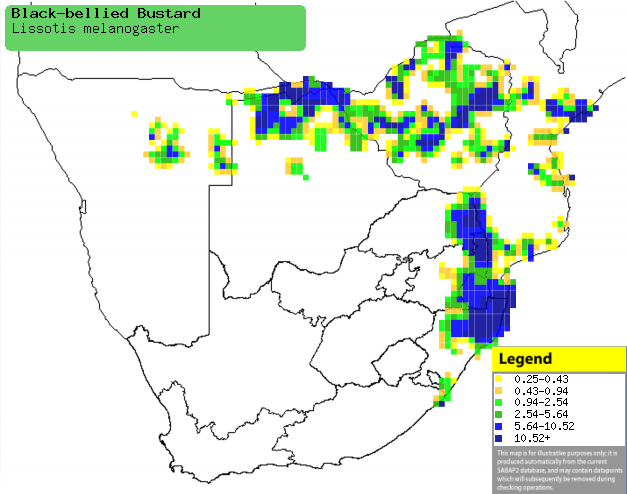|
Lissotis melanogaster
(Black-bellied bustard, Black-bellied korhaan)
[= Eupodotis melanogaster]
Langbeenkorhaan [Afrikaans]; uFumba, uNofunjwa
[Zulu]; Epampa (generic term for korhaan) [Kwangali]; Guhwi [Shona];
Umfumbane [Swazi]; Xicololwana lexi kulu [Tsonga]; Zwartbuiktrap
[Dutch]; Outarde à ventre noir [French]; Schwarzbauchtrappe
[German]; Abetarda-de-barriga-preta [Portuguese]
Life
> Eukaryotes
>
Opisthokonta
> Metazoa
(animals) > Bilateria > Deuterostomia >
Chordata > Craniata > Vertebrata (vertebrates) > Gnathostomata (jawed
vertebrates) > Teleostomi (teleost fish) > Osteichthyes (bony fish) > Class:
Sarcopterygii (lobe-finned fish) > Stegocephalia (terrestrial vertebrates) >
Tetrapoda (four-legged vertebrates) > Reptiliomorpha > Amniota >
Reptilia
(reptiles) > Romeriida > Diapsida > Archosauromorpha > Archosauria >
Dinosauria (dinosaurs) > Saurischia > Theropoda (bipedal predatory
dinosaurs) > Coelurosauria > Maniraptora > Aves (birds) >
Order: Gruiformes
> Family: Otitidae
The Black-bellied bustard occurs from Senegal east to
Ethiopia, extending south to southern Africa, where it is uncommon to locally
common in a wide variety of mainly grassy habitats. Its diet is little known in
southern Africa, but elsewhere it is omnivorous, mainly feeding feeding on small
invertebrates, such as locusts, grasshoppers and beetles, as well as vegetable
matter, such as fruit, seeds and leaves. The male does an elaborate courtship
display to multiple females, whom he mates with afterwards. The incubating and
parenting is done solely by the female, who protects intruders who get to close
to the "nest", which is a bare scrape in the ground, with wings outstretched.
Distribution and habitat
Occurs across sub-Saharan Africa; in southern Africa it is
uncommon to locally common in north-eastern Namibia (including the Caprivi
Strip), northern Botswana, Zimbabwe, Mozambique and eastern South Africa. It
generally prefers tall, dense
woodland and grassy savanna as well as cultivated pastures, fields, fallow lands
and woodland, such as cluster-leaf (Terminalia), Baikaea plurijaga
(Zambezi teak), bushwillows (Combretum), Mopane (Colospermum mopane) and
miombo (Brachystegia).
|
 |
|
Distribution of Black-bellied bustard in southern Africa,
based on statistical smoothing of the records from first SA Bird Atlas
Project (©
Animal Demography unit, University of
Cape Town; smoothing by Birgit Erni and Francesca Little). Colours range
from dark blue (most common) through to yellow (least common).
See here for the latest distribution
from the SABAP2. |
Predators and parasites
Food
Its diet is little known in southern Africa, but elsewhere
it is omnivorous, mainly feeding on small invertebrates, such as
locusts, grasshoppers and beetles, as well as vegetable matter, such as fruit,
seeds and leaves. The following food items have been recorded in its diet
outside of southern Africa:
- Invertebrates
- Plant matter
- berries
- seeds
- fruits
- flowers
- palm kernels
- green leaves
Breeding
- Polygynous, solitary nester, with one male doing an elaborate courtship
display to multiple females, whom he mates with afterwards.
- The eggs are laid directly on the ground, often among tufts of tall
grass
- Egg-laying season is from about September-March.
- It lays 1-2 eggs, which are incubated solely by the female.
- The chicks are cared for by the mother, who chases away intruders, such
as
warthog, if they get to close to her
young.
Threats
Globally not threatened, although it is near-threatened in
South Africa, largely due to habitat destruction, hunting and overgrazing.
References
-
Hockey PAR, Dean WRJ and Ryan PG (eds) 2005. Roberts -
Birds of southern Africa, VIIth ed. The Trustees of the John Voelcker
Bird Book Fund, Cape Town.
|
